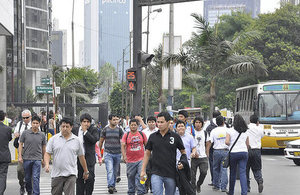Despite recent economic deceleration, Peru’s economy remains strong
The upgrade in Moody’s investment rating, a commitment to develop Public-Private Partnerships, and a new strategic plan by the National Competition Council, confirm Peru’s economic strength.

Lima's financial district.
A new economic stimulus package launched by the government is expected to boost the economy in the short-term. The package, announced on Independence Day (28th July), is currently being debated in Congress. If approved, the measures would benefit the construction sector which has been leading the economic growth of the previous months. An increase from 5% to 20% on the accelerated depreciation regime (allowing construction companies to register greater deductions of their assets for accounting purposes) is one of the main proposals. A presidential decree was also issued to implement some expansionary reforms immediately. These included an increase to the National Holidays bonus for public workers (a bonus equivalent to one month’s salary that is paid in July and December) and allowed temporary access to the length-of-service income (each formal worker receives an additional wage per year which, under normal conditions, can only be accessed during unemployment). These measures announced in the decree represented an investment of 0.3% GDP and have the objective of stimulating the private demand.
Peru’s Central Bank reduced its benchmark interest rate from 4% to 3.75% in an attempt to stimulate increased economic growth. The Bank’s Economic Research Department reported that inflation has been decelerating and will reach the target range of 1 – 3% next year.
Moody’s agency raised Peru’s investment rating to A3, placing it second behind Chile in the region and on a par with Mexico and Malaysia. Moody’s cited continued structural reform to boost potential output growth while addressing institutional constraints, expectation of continued strengthening of the government’s balance sheet and fiscal framework, and an expected acceleration of economic activity through 2016 underpinning a sustained improvement in credit metrics relative to similarly-rated peers.
Peru’s commitment to developing Public-Private Partnerships as an investment mechanism in social sectors continued with the launch of a major education portfolio. With a total investment last year of around £600million, it would take two generations to meet the estimated £12, 500 million infrastructure gap in education. To increase the rate of investment a new program of 10-30 year PPP packages to replace or renovate residential schools (construction, maintenance and equipment) was launched in July, and PPP packages for technical institutions (construction, maintenance, equipment and management) are due to be launched in the near future. The first health sector PPP project was launched in July; other projects are being developed in justice (prisons) and science & innovation.
The National Competition Council launched their strategic plan 2014-18 on 22 July, setting out 65 measures over 8 priority themes (science & innovation, internationalisation, productivity and business development, logistics and transport infrastructure, human capital, ICT, business facilitation and natural resources & energy) to boost Peru’s competitiveness. The previous strategy saw a 79% increase in state funding for science and innovation, a 1398% increase in science and innovation scholarships, a significant expansion of the fibre optic network, and a 53% reduction in the time taken to secure a patent. The new strategy aims to deliver a 15% average increase in worker productivity and a 5% reduction in informality.